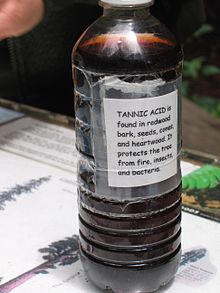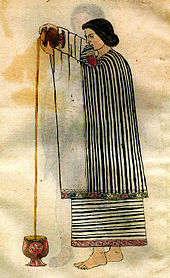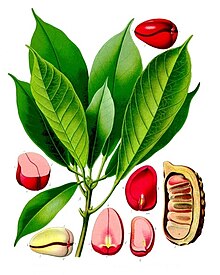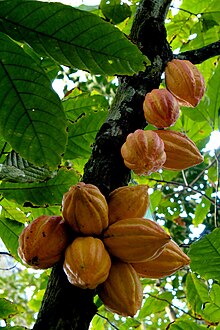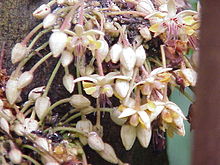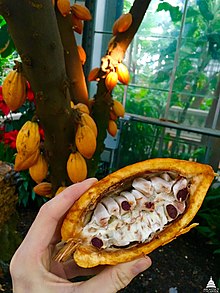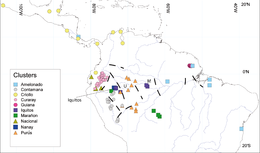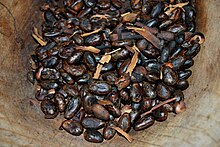
| |
| Names | |
|---|---|
| IUPAC name
1,2,3,4,6-penta-O-{3,4-dihydroxy-5-[(3,4,5-trihydroxybenzoyl)oxy]benzoyl}-D-glucopyranose
| |
| Systematic IUPAC name
2,3-dihydroxy-5-({[(2R,3R,4S,5R,6R)-3,4,5,6-tetrakis({3,4-dihydroxy-5-[(3,4,5-trihydroxyphenyl)carbonyloxy]phenyl}carbonyloxy)oxan-2-yl]methoxy}carbonyl)phenyl
3,4,5-trihydroxybenzoate
| |
| Other names
Acidum tannicum
Gallotannic acid Digallic acid Gallotannin Tannimum Quercitannin Oak bark tannin Quercotannic acid Querci-tannic acid Querco-tannic acid | |
| Identifiers | |
3D model (JSmol)
|
|
| 8186386 | |
| ChEBI | |
| ChEMBL | |
| ChemSpider | |
| ECHA InfoCard | 100.014.321 |
| KEGG | |
PubChem CID
|
|
| UNII | |
CompTox Dashboard (EPA)
|
|
| Properties | |
| C76H52O46 | |
| Molar mass | 1701.19 g/mol |
| Density | 2.12g/cm3 |
| Melting point | decomposes above 200 °C |
| 2850 g/L or 250 g/L | |
| Solubility | 100 g/L in ethanol 1 g/L in glycerol and acetone insoluble in benzene, chloroform, diethyl ether, petroleum, carbon disulfide, carbon tetrachloride. |
| Acidity (pKa) | ca. 6 |
Except where otherwise noted, data are given for materials in their standard state (at 25 °C [77 °F], 100 kPa).
| |
A bottle of tannic acid (water solution).
Tannic acid is a specific form of tannin, a type of polyphenol. Its weak acidity (pKa around 6) is due to the numerous phenol groups in the structure. The chemical formula for commercial tannic acid is often given as C76H52O46,
which corresponds with decagalloyl glucose, but in fact it is a mixture
of polygalloyl glucoses or polygalloyl quinic acid esters with the
number of galloyl
moieties per molecule ranging from 2 up to 12 depending on the plant
source used to extract the tannic acid. Commercial tannic acid is
usually extracted from any of the following plant parts: Tara pods (Caesalpinia spinosa), gallnuts from Rhus semialata or Quercus infectoria or Sicilian sumac leaves (Rhus coriaria).
According to the definitions provided in external references such as international pharmacopoeia, Food Chemicals Codex
and FAO-WHO tannic acid monograph only tannins sourced from the
above-mentioned plants can be considered as tannic acid. Sometimes
extracts from chestnut or oak wood are also described as tannic acid but this is an incorrect use of the term. It is a yellow to light brown amorphous powder; 2850 grams dissolves in one litre of water (1.7 moles per liter).
While tannic acid is a specific type of tannin
(plant polyphenol), the two terms are sometimes (incorrectly) used
interchangeably. The long-standing misuse of the terms, and its
inclusion in scholarly articles has compounded the confusion. This is
particularly widespread in relation to green tea and black tea, both of
which contain tannin but not tannic acid.
Tannic acid is not an appropriate standard for any type of tannin analysis because of its poorly defined composition.
Quercitannic and gallotannic acids
Quercitannic acid is one of the two forms of tannic acid found in oak bark and leaves. The other form is called gallotannic acid and is found in oak galls.
The quercitannic acid molecule is also present in quercitron, a yellow dye obtained from the bark of the Eastern black oak (Quercus velutina), a forest tree indigenous in North America. It is described as a yellowish-brown amorphous powder.
In 1838, Jöns Jacob Berzelius wrote that quercitannate is used to dissolve morphine.
In 1865 in the fifth volume of "A dictionary of chemistry", Henry Watts wrote :
It exhibits with ferric salts the same reactions as gallotannic acid. It differs however from the latter in not being convertible into gallic acid, and not yielding pyrogallic acid by dry distillation. It is precipitated by sulfuric acid in red flocks. (Stenhouse, Ann. Ch. Pharm. xlv. 16.)
According to Rochleder (ibid lxiii. 202), the tannic acid of black tea is the same as that of oak-bark.
In 1880, Etti gave for it the molecular formula C17H16O9. He described it as an unstable substance, having a tendency to give off water to form anhydrides (called phlobaphenes), one of which is called oak-red (C34H30O17). For him, it was not a glycoside.
In Allen's "Commercial Organic Analysis", published in 1912, the formula given was C19H16O10.
Other authors gave other molecular formulas like C28H26O15, while another formula found is C28H24O11.
According to Lowe, two forms of the principle exist – one soluble in water, of the formula C28H28O14, and the other scarcely soluble, C28H24O12. Both are changed by the loss of water into oak red, C28H22O11.
Quercitannic acid was for a time a standard used to assess the phenolic content in spices, given as quercitannic acid equivalent.
In an interesting historical note, the inventor Edward G. Acheson
(Inventor of Carborundum) discovered that gallotannic acid greatly
improved the plasticity of clay. In his report of this discovery in 1904
he noted that the only known historical reference to the use of organic
material added to clay is the use of straw mixed with clay described in
the Bible, Exodus 1:11 and that the Egyptians must have been aware of
his (re-)discovery. He stated "This explains why the straw was used and
why the children of Israel were successful in substituting stubble for
straw, a course that would hardly be possible, were the fibre of the
straw depended upon as a bond feasible for the clay, but quite
reasonable where the extract of the plant was used."
Uses
Tannins are a basic ingredient in the chemical staining of wood, and are already present in woods like oak, walnut, and mahogany.
Tannic acid can be applied to woods low in tannin so chemical stains
that require tannin content will react. The presence of tannins in the
bark of redwood (Sequoia) is a strong natural defense against wildfire, decomposition, and infestation by certain insects such as termites. It is found in the seeds, bark, cones, and heartwood.
Tannic acid is a common mordant used in the dyeing process for cellulose fibers such as cotton, often combined with alum and/or iron.
The tannin mordant should be done first as metal mordants combine well
with the fiber-tannin complex. However this use has lost considerable
interest.
Similarly tannic acid can also be used as an aftertreatment to improve wash fastness properties of acid dyed polyamide.
It is also an alternative for fluorcarbon aftertreatments to impart
anti-staining properties to polyamide yarn or carpets.
However, due to economic considerations currently the only widespread
use as textile auxiliary is the use as an agent to improve chlorine
fastness, i.e. resistance against dye bleaching due to cleaning with
hypochlorite solutions in high-end polyamide 6,6-based carpets and
swimwear. It is, however, used in relatively small quantities for the
activation of upholstery flock; this serves as an anti-static treatment.
Tannic acid is used in the conservation of ferrous (iron based)
metal objects to passivate and inhibit corrosion. Tannic acid reacts
with the corrosion products to form a more stable compound, thus
preventing further corrosion from taking place. After treatment the
tannic acid residue is generally left on the object so that if moisture
reaches the surface the tannic acid will be rehydrated and prevent or
slow any corrosion. Tannic acid treatment for conservation is very
effective and widely used but it does have a significant visual effect
on the object, turning the corrosion products black and any exposed
metal dark blue. It should also be used with care on objects with
copper alloy components as the tannic acid can have a slight etching
effect on these metals.
Tannic acid is also found in commercially available iron/steel corrosion treatments, such as Hammerite Kurust.
Use in food
Use
of tannic acid in food applications is widespread; significant amounts
are used as process aids in beer clarification, aroma compound in soft
drinks and juices. Also important are applications in the wine industry,
where it finds use as a natural clarifying agent, colour stabilizer and
taste enhancer.
In many parts of the world, such uses are permitted. In the United States, tannic acid is generally recognized as safe by the Food and Drug Administration.
According to EU directive 89/107/EEC tannic acid cannot be considered as a food additive and consequently does not hold an E number.
Under directive 89/107/EEC tannic acid can be referred to as a food
ingredient. The E-number E181 is sometimes incorrectly used to refer to
tannic acid; this in fact refers to the INS number assigned to tannic acid under the FAO-WHO Codex Alimentarius system.
Uses as a medication
In
conjunction with magnesium and sometimes activated charcoal, tannic
acid was once used as a treatment for many toxic substances, such as strychnine, mushroom, and ptomaine poisonings in the late 19th and early 20th centuries.
The introduction of tannic acid treatment of severe burn injuries in the 1920s significantly reduced mortality rates. During World War I, tannic acid dressings were prescribed to treat "burns, whether caused by incendiary bombs, mustard gas, or lewisite. After the war this use was abandoned due to the development of more modern treatment regimens.
Tannic acid is still used in pharmaceutical applications to produce albumin tannate which is used as an antidiarrheal agent. Tannic acid is also used to produce tannate salts of certain antihistamine and antitussive products to impart increased stability or slow release properties to the active pharmaceutical ingredient. Further to this, tannic acid is the principal but perhaps minimally effective ingredient in anti-allergy sprays.
Tannins have also been reported to exert many physiological
effects, such as to accelerate blood clotting, reduce blood pressure,
decrease the serum lipid level, produce liver necrosis, and modulate
immunoresponses.
This would explain common folklore such as that soaking feet in tannic
acid (or strong tea) can treat or prevent blisters, foot odor and rough,
dry feet.
Hazards
Tannic
acid could cause potential health hazards such as damage to the eye,
skin, respiratory tract, and gastrointestinal tract. It may cause
irritation, redness, pain, blurred vision, and possible eye damage. When
tannic acid is absorbed through the skin in harmful amounts, it may
cause irritation, redness, and pain. Nausea, vomiting and diarrhoea are
symptoms of tannic acid ingestion and prolonged exposure may cause liver
damage. Upon inhalation, tannic acid may cause respiratory tract
irritation.
Crocodilian coloration
Skin color in Crocodilia
(crocodiles and alligators) is very dependent on water quality.
Algae-laden waters produce greener skin, while tannic acid in the water
from decay of leaves from overhanging trees (which produces some types
of blackwater rivers) often produce darker skin in these animals.
